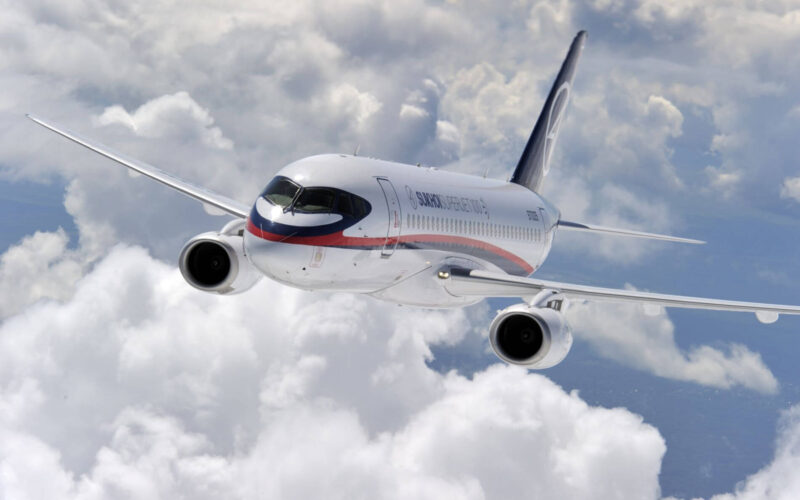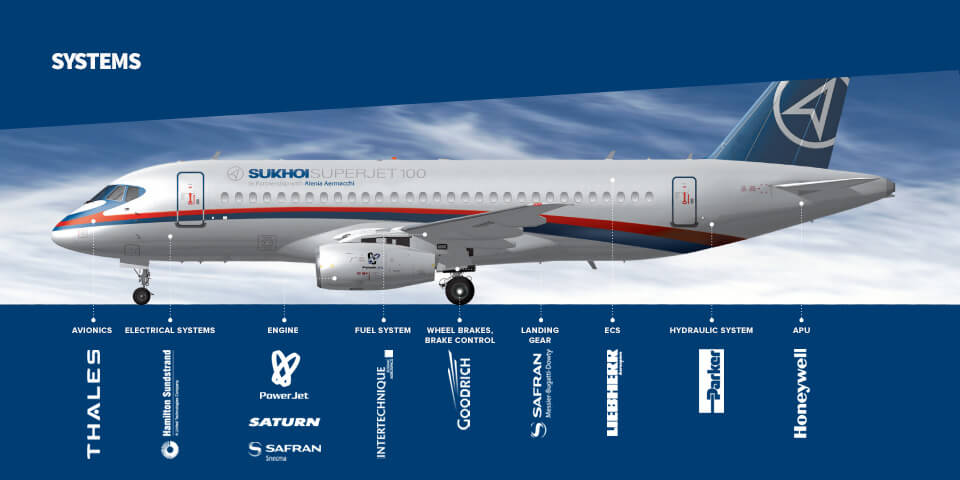There were many problems with the new Russian regional airliner program right from the beginning. One of them – at least according to some – was the fact that the aircraft itself was not really that Russian. United Aircraft Corporation (UAC) is slowly trying to change that, but the task is not as easy as it appeared at first.
The story of what later became known as SSJ 100, Sukhoi SuperJet, Superjet 100, and by many other names, began in the early 2000s. Cooperation between Russia and the West was at all-time high, so everything the post-soviet economy could not do was supposed to be easily procured elsewhere. Avionics, hydraulics, APU, and many other high-tech components for the new shining product of re-emerging Russian aviation industry were made by the leading European and American manufacturers. Even the marketing was to be handled by Boeing.
But SSJ 100’s road to reality was bumpy, as was the geopolitical situation in the coming decades. One of the keywords of Russian economy after the 2014 Crimea crisis was “importozameschenie” – import substitution, a massive program supposed to replace products that were either cut-off by Western sanctions or prohibited by Russian government in response to them.
High hopes
Although the development SSJ 100 was not touched by the sanctions, its prestige was. The fact that more than half of Superjet’s systems were built by the “potential enemy” became a joke in Russian infosphere, a sentiment fueled by conspiracy theories about the causes of aircraft’s problems.
So, the first plans for substituting foreign-made SSJ 100 parts came in 2015. The aim was to increase the amount of Russian-made elements from 45% to at least 50-60% by replacing 22 components and systems. Several contradicting deadlines for this change were named, placing the first deliveries of the new mostly Russian-made Superjets between 2018 and 2022.
Somewhere along the line the deadline was pushed to 2024, and, together with the change of hands, the new name was proposed – SSJ100R, R obviously meaning Russian. The amount of replaced components was still kept at 10-15%, bringing into question the basis behind all the fuss, as almost half of the aircraft was still not domestically produced. But the program continued, with government subsidies totalling 18.5 billion roubles (over $250 million), most of it for research and development.
Another push also came in 2018, this time from Iran. As Donald Trump announced an additional round of sanctions against the Middle-Eastern country, any product with more than 10% of U.S.-made parts had to get clearance from the State Department before being sold there. Iran was one of the main potential buyers of the SSJ 100, but over one tenth of the plane’s parts – including APU, electric systems, wheels, brakes and much more – was of American origin.
After initial unfruitful attempts to request the clearance, the strategy was changed. According to the Russian media, Iran became “greatly interested” in acquiring the new modification of the airplane with an increased amount of Russian-made parts. It was renamed to SSJ 100 New. Presumably, the new English word in the name was not counted as a foreign component.
The present and the future
Currently, as of mid-2020, the project is still in the development phase, but its updates became a steady stream of news in the world of Russian aviation. Contracts to produce landing gear, passenger seats, electronics, as well as hydraulic, conditioning, emergency, and other systems were signed with a number of Russian companies, in addition to plans to develop new all-Russian composite alloys. As per deal with Iran, the focus of the change is on American-made elements; as per propaganda value, the manufacturer is changing everything that can possibly be substituted. The full extent of “russification” was not disclosed, but it is clear that the initial aim of increasing domestically made components by 15% was surpassed.
And while the COVID-19 pandemic has dealt a massive blow to the aviation industry worldwide, it may have injected even more life into the project. In May 2020, Vladimir Putin issued a direct order to pull the end date of the development from 2024 to 2023. According to the Russian president, the new regional aircraft is well-suited to the post-COVID world of almost non-existing international and re-emergent domestic travel.
Importantly, potential buyers do not have to agree with this statement. Domestic market is the main niche for the plane and the reorganizing Aeroflot has already pledged to acquire 150 SSJ 100s for its low-cost subsidiaries, if not for economical, then for patriotic reasons. It is unknown how many of them will be “New”s, but since patriotic zeal plays a substantial part in the carrier’s reorganization, it could be expected that Iran will not be the only buyer of SSJ 100 New.


